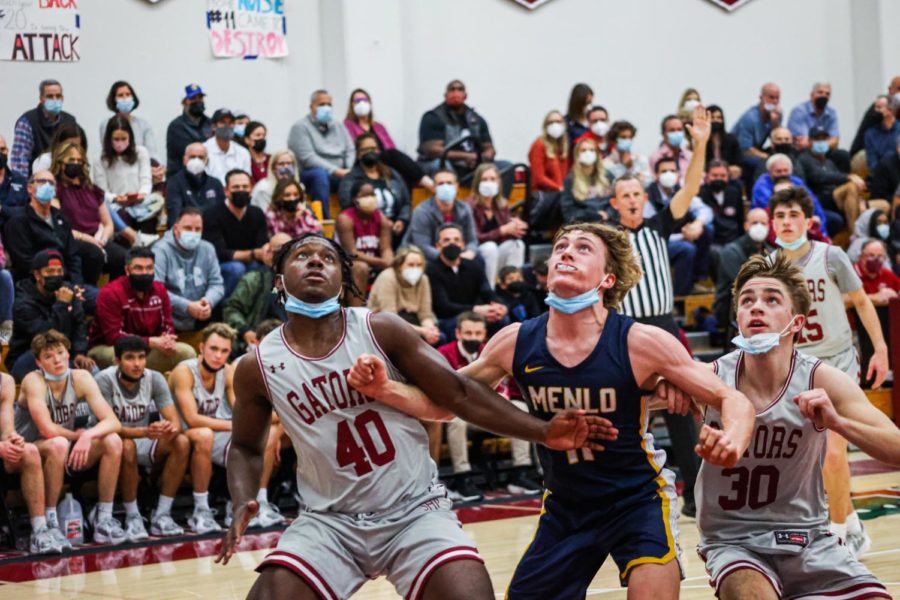Two Years In, It’s Time To Start Living Freely
California high school basketball players are still required to have masks on their face, although almost all players have worn them under their chin to prevent fatigue, shortness of breath or loss of consciousness. Despite no medical advantages, this routine continues to be mandated and practiced across the state. Staff photo: Lexi Friesel.
February 3, 2022
Two. Long. Years. That’s how long it’s been since COVID-19 was first detected in America, and that’s how long it’s been since people started panicking about it. At first, the panic made sense: scientists knew barely anything about preventing transmission, hospitals were rapidly filling up and perfectly healthy people were spreading a potentially deadly disease. Fast-forward two years, and the virus still causes widespread anxiety — but now science suggests that we should be far less concerned, so it’s likely time to pull the plug on virus restrictions such as all-encompassing mask mandates that hamper the lives of many healthy Americans.
“Minor sacrifices for the greater good” has been the motto that our governor, our county, our school and our television news hosts have been preaching for the past two years. Often this meant that anyone who chose to not abide by every single COVID restriction was villainized, such as last winter when LA mayor Eric Garcetti vowed to “hunt down” any rule breakers. This year, COVID case rates are fairly similar, but there are a couple huge differences: mortality rates are way lower, and healthy, vaccinated people are rarely affected (more on that last one later). It’s time for governments and schools to start allowing for “the vaccinated lifestyle,” as New York Times COVID-19 expert David Leonhardt put it, because all Americans have access to extremely effective vaccines and booster shots to mitigate serious illness.
The recent rise in cases due to the Omicron variant may have triggered a nationwide hysteria, but after a month, we know quite a bit more about it, and it’s a lot less intimidating than it originally seemed. It triggered the most daily cases that America has had, but deaths have stayed relatively low, according to New York Times data. South Africa — one of the first countries to be hit with the omicron variant — saw their death rate fall from 8% to 0.2% in the month following the variant outbreak, and mortality rates appear to be similar in the United States, although the full scope is still hard to tell due to the more recent arrival of the variant.
That means that the current COVID-19 death rate is comparable to that of the seasonal flu (around 0.14% depending on the strain), according to Center for Disease Control and Prevention data. That’s right, the virus that is affecting the way we attend school, the way we work and the way our economy functions has a similar impact on infected people as the seasonal flu. Plus, new groundbreaking medications along with a 90% effective booster shot — both against hospitalizations and asymptomatic infection — are paving the way for an even lower death rate in the near future.
So, why can’t we learn to live with it the way we’ve lived with the flu our whole lives? We’ve been repeatedly told that because it’s significantly more contagious, it’s all of our responsibility to protect those around us. This logic may have made sense when we saw a measurable end in sight (the release of mRNA vaccines to the public in spring 2021), but it’s no longer feasible with this pandemic looking more and more like an endemic. Vaccines are available to everyone over five, and according to CDC Director Rochelle Walensky, over 75% of vaccinated people who have died since October had four or more comorbidities. We’ve known since the start of the pandemic that preexisting conditions increase the chance of death, but this new research is shockingly optimistic for those without them.
On the one hand, people with a high amount of comorbidities likely have a lot of tough lifestyle choices, as they must constantly balance both quality of life and risk of exposure. And nobody can make that decision but that person themself. However, there’s now more and more evidence that anyone with risk factors can still protect themselves extremely: as Harvard University’s Joseph G. Allen wrote, “For anyone who fears moving away from universal masking, the great news is that they can continue to wear an N95 mask — along with being vaccinated and boosted — and live a low-risk life regardless of what others around them are doing.”
And when it comes to everyone else, the death rate for healthy, vaccinated people is over four times lower than the 0.2% figure cited earlier, which comes out to be 0.05%, or one in 2,000.
One in 2,000 — a stark difference from the over one in 100 death rate we assumed for most of the last two years.
There are also the statistics for children, who are one of the groups most psychologically damaged by pandemic restrictions in the form of school shutdowns. According to Jan. 13 American Academy of Pediatrics data from 46 states, the COVID-19 death rate in minors was between 0.00% and 0.02%. In other words, the highest rate recorded was one in 5,000, while other states have had as few as zero children die of the virus.
A year ago, this data would have been brushed aside and children would have been told to take one for the team and continue living a reduced social life. But with vaccines that are strong against preventing infection and take death rates down to near-zero, it’s no longer fair to impose widespread restrictions on companies and schools. We’ve reached a point where every person has enough information to decide for themselves what the risks of various activities are, and after two whole years it’s time to stop punishing innocent, healthy people with limited lifestyles.
Now I know, people who support continuing restrictions may argue that my view is very skewed because people of my age range and overall health are the ones that benefit most from loosened rules. True. But at the same time, all of the data I’ve cited explains that it’s not just minors that are at minimal risk; rather, the greater part of vaccinated, boosted Americans fall into that category. To emphasize the lack of risk for most Americans, vehicle crashes present a larger risk than COVID for healthy, middle-aged people, according to data analysis conducted by Leonhardt
With all of this in mind, here’s my proposal: governments and schools should take a hands-off approach to minding the daily lives of Americans. If individuals, families or groups choose to be more cautious, it’s well within reason and may be appropriate, depending on the situation. But it’s been two years and the virus doesn’t have the impact on healthy Americans that we previously believed, so the time for sweeping mandates has passed.




